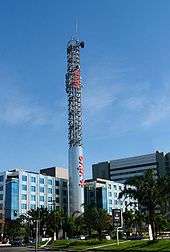Vivo (telecommunications)
 | |
| Subsidiary | |
| Industry | Telecomunications |
| Founded | 1993 (Launched as TELESP Celular) (Vivo brand launched at April 13, 2003) |
| Headquarters | São Paulo, SP, Brazil |
Key people | Paulo Cesar Teixeira (CEO) |
| Products | Fixed line, Mobile telecommunications, internet services and digital television |
| Revenue |
|
|
| |
Number of employees | 8,386 |
| Parent | Telefónica |
| Website | www.vivo.com.br |
Vivo (IPA: [ˈvivu], Portuguese for "alive"), legally known as Telefônica Brasil, is the largest telecommunications company in Brazil. It is headquartered in São Paulo.
History
The company was originally formed as part of Telebrás, the state-owned telecom monopoly at the time. In 1998, Telebrás was demerged and privatized, with Telefónica taking Telesp. Telesp was rebranded as Telefonica from 1998 until April 15, 2012, when all Telefonica services were rebranded again to Vivo, using the same strategy of unifying all its services in a unique brand, like Movistar (Hispanic America and Spain) and O2 (rest of Europe). Currently, the Telefonica brand is only used for the group Telefônica Brasil.

Vivo brands
Vivo owns the following brands:
- Vivo Móvel (mobile service)
- Vivo Fixo (landline service, formerly Linha Fixa da Telefônica)
- Vivo Internet Casa
- Vivo 15 (long distance and international calling, formerly 15 da Telefônica and Super 15)
- Vivo HDTV (satellite television, formerly Telefónica TV Digital, GVT TV and Vivo TV)
- Vivo TV Plus (cable television, formerly TVA)
- Vivo TV Fibra (FTTH television service, formerly Fibra TV da Telefônica)
Vivo Móvel
The Vivo brand was launched on April 13, 2003, as a mobile phone service provider. It's the largest provider in Brazil with over 76 million users.[1] It originated from the merger of several Brazilian mobile phone operations under a joint-venture owned equally by Portugal Telecom (PT) and Spain's Telefónica. Until 2006, the group was composed of six holding companies which, as announced in November 2005, merged into a single holding company, Vivo Participações S.A.. The operation was concluded on February 22, 2006. In July 2010, Telefónica bought PT's shares.[2][3]
Most of its network was initially based on IS-95, though there were parts of it that were still analog AMPS and parts (resulting from acquisition of other companies) using TDMA (IS-136). These are all being converted to GSM since 2006, when, after years being the only CDMA network, Vivo announced a GSM network, and that it would operate in both CDMA and GSM.[4] The CDMA network was gradually converted to CDMA2000 in the major cities. All CDMA network was discontinued on November 2012[5]
Today Vivo operates an UMTS, HSDP 3G networks and band 7 4G LTE in major cities.
Merged companies
The following operators merged to form Vivo:
Owned by Portugal Telecom
- Telesp Celular (São Paulo)
- Global Telecom (Paraná, Santa Catarina)
- Norte Brasil Telecom (a.k.a. NBT) (Amazonas, Roraima, Pará, Amapá, Maranhão)
Owned by Telefónica
- Telefónica Celular (Rio de Janeiro, Espírito Santo, Rio Grande do Sul)
- Telebahia Celular (Bahia)
- Telergipe Celular (Sergipe)
Acquired by the joint venture
- TCO Celular (Goiás, the Federal District, Acre, Tocantins, Mato Grosso, Mato Grosso do Sul)
- Telemig Celular (Minas Gerais)
New operations in the Northeast region
- Vivo (Ceará, Alagoas, Rio Grande do Norte, Pernambuco, Paraíba, Piauí), since October 2008.
See also
References
- ↑ (in Portuguese) Milhões de brasileiros conectados http://www1.folha.uol.com.br/mercado/2013/05/1281967-com-763-milhoes-de-clientes-vivo-lidera-mercado-com-288-de-particpacao.shtml/title=50 Milhões de brasileiros conectados Check
|url=value (help). Retrieved 2009-12-21. Missing or empty|title=(help) - ↑ Woolls, Daniel (28 July 2010). "Telefonica: new deal with PT to buy Brazil's Vivo". The Seattle Times.
- ↑ Paul Tobin; Anabela Reis (28 July 2010). "Telefonica Agrees to Buy Vivo Stake for $9.8 Billion". Bloomberg.
- ↑ "O que muda com a ida da Vivo para o GSM" (in Portuguese). Retrieved 18 May 2007.
- ↑ http://www.vivo.com.br/portalweb/appmanager/env/web?_nfpb=true&_pageLabel=P1200158371317391404067&_nfls=false#